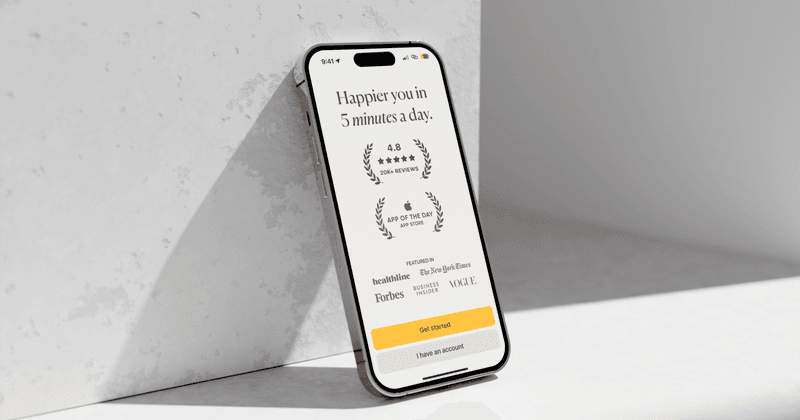Five Minute Journal is a popular mindfulness app that helps users develop positive daily habits through journaling. But like many subscription-based apps, it struggled to convert new users into paying subscribers. To address this, we redesigned the onboarding experience using the Jobs-to-be-Done (JTBD) framework, focusing on personalizing the flow, integrating social proof, and clearly communicating the app’s core benefits. The result? A 20% increase in average revenue per user (ARPU), alongside improvements in trial start rates and trial conversions.
In this article, we’ll walk you through the key challenges we faced, the approach we took, and the results of our onboarding redesign.
The challenge: low conversion to trial and day-one retention
Like many subscription-based apps, Five Minute Journal’s success depends on guiding new users through onboarding, quickly demonstrating the value of the app, and converting them into paying subscribers. However, the initial experience for new users was not great, causing drop-offs throughout the flow. Onboarding hadn’t been updated for a while, and the structure and positioning of the screens felt a bit outdated compared to competitors and the wider industry.
Our hypothesis: By making the onboarding flow more personalized, incorporating social proof, and clearly highlighting the app’s core benefits, we could significantly boost user engagement and revenue. This would lead to an estimated 10-20% uplift in trial start rates, trial conversion rates, and ARPU.
“Increasing our ARPU is critical to scaling the Five Minute Journal app”
— Darius Mora, Intelligent Change
Our approach: applying the Jobs-to-be-Done framework
We started by asking a fundamental question: Which “jobs” are users hiring Five Minute Journal to do? This helped us shift our focus from simply presenting features to demonstrating how the app can help users achieve their goals, such as building a daily mindfulness routine or fostering positive habits.
Once we understood these segments, we focused on three key motivations:
Personalization: We tailored the onboarding content to resonate with user needs, framing the app as a solution to their specific challenges.

Social proof: We integrated testimonials and success stories early in the onboarding flow to build credibility and trust.

Highlighting benefits: Instead of focusing on app features, we clearly articulated the value of Five Minute Journal from the user’s perspective, helping them understand how the app would benefit them.

What we learned: Three key takeaways
- The design and development process can be lengthy but worth it.
It’s different for every app, but from our experience, it can take 2-3 months to go through the whole process—from user research to design to development—so it’s important to consider this timeline when revamping your onboarding experience. - Having the right tools and measurement in place makes experiment design a smooth process.
Our rigorous approach to A/B testing meant we agreed on key success metrics in advance with Five Minute Journal, measured confidence levels via Analytics Toolkit to ensure our results were valid, and tested everything via our QA process before launching. The execution would not have been possible without the right tools to enable us to launch and measure our changes accurately. Our stack with Five Minute Journal includes Amplitude for analysis, RevenueCat for subscription management, and Firebase for test setup. - The first iteration was a success, but it’s only the beginning.
- Higher ARPU: The average revenue per user (ARPU) increased by 20% (p-value = 0.04).
- More trials started and converted: ~10% and ~14% respectively.
It’s important to understand any drop-off points to inform any tweaks or changes for the next iteration. We’ll continue to experiment and refine, always with the goal of better serving our users.
Conclusion — Improving your onboarding experience takes time, but it’s worth it!
Our experience with Five Minute Journal’s onboarding redesign highlights the power of personalization, social proof, and clear communication. By aligning the onboarding flow with users’ real needs and demonstrating value from the outset, we were able to significantly improve user engagement and drive conversions.
About Five Minute Journal
Five Minute Journal is a popular mindfulness app designed to help users develop positive daily habits through journaling. The app encourages users to reflect on their day, set intentions, and cultivate gratitude — all in just five minutes a day. We’re currently working on some exciting new features that will improve the overall UX and increase Five Minute Journal’s competitiveness in the market.
About Applica
Applica is a growth partner for mobile and web apps, focused on delivering results through experimentation, organic growth, and paid promotion. Our clients value our behavioural-driven approach, fast-paced optimisations, and deep expertise. See the Five Minute Journal case study on Behance.

